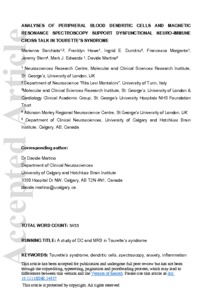Sarchioto, M; Howe, F; Dumitriu, IE; Morgante, F; Stern, J; Edwards, MJ; Martino, D
(2021)
Analyses of peripheral blood dendritic cells and magnetic resonance spectroscopy support dysfunctional neuro‐immune crosstalk in Tourette syndrome.
European Journal of Neurology, 28 (6).
pp. 1910-1921.
ISSN 1351-5101
https://doi.org/10.1111/ene.14837
SGUL Authors: Morgante, Francesca
![[img]](https://openaccess.sgul.ac.uk/113093/1.hassmallThumbnailVersion/ene.14837.pdf)  Preview |
|
PDF
Accepted Version
Available under License ["licenses_description_publisher" not defined].
Download (20MB)
| Preview
|
Abstract
Background
Evidence supports that neurodevelopmental diseases, such as Tourette syndrome (TS), may involve dysfunctional neural‐immune crosstalk. This could lead to altered brain maturation and differences in immune and stress responses. Dendritic cells (DCs) play a major role in immunity as professional antigen‐presenting cells; changes in their frequency have been observed in several autoimmune conditions.
Methods
In 18 TS patients (15 on stable pharmacological treatment, three unmedicated) and 18 age‐matched healthy volunteers (HVs), we explored circulating blood‐derived DCs and their relationship with clinical variables and brain metabolites, measured via proton magnetic resonance spectroscopy (1H‐MRS). DC subsets, including plasmacytoid and myeloid type 1 and 2 dendritic cells (MDC1, MDC2), were studied with flow cytometry. 1H‐MRS was used to measure total choline, glutamate plus glutamine, total creatine (tCr), and total N‐acetylaspartate and N‐acetylaspartyl‐glutamate levels in frontal white matter (FWM) and the putamen.
Results
We did not observe differences in absolute concentrations of DC subsets or brain inflammatory metabolites between patients and HVs. However, TS patients manifesting anxiety showed a significant increase in MDC1s compared to TS patients without anxiety (p = 0.01). We also found a strong negative correlation between MDC1 frequency and tCr in the FWM of patients with TS (p = 0.0015), but not of HVs.
Conclusion
Elevated frequencies of the MDC1 subset in TS patients manifesting anxiety may reflect a proinflammatory status, potentially facilitating altered neuro‐immune crosstalk. Furthermore, the strong inverse correlation between brain tCr levels and MDC1 subset frequency in TS patients suggests a potential association between proinflammatory status and metabolic changes in sensitive brain regions.
| Item Type: |
Article
|
| Additional Information: |
This is the peer reviewed version of the following article: Sarchioto, M., Howe, F., Dumitriu, I.E., Morgante, F., Stern, J., Edwards, M.J. and Martino, D. (2021), Analyses of peripheral blood dendritic cells and magnetic resonance spectroscopy support dysfunctional neuro-immune crosstalk in Tourette syndrome. Eur J Neurol, 28: 1910-1921, which has been published in final form at https://doi.org/10.1111/ene.14837. This article may be used for non-commercial purposes in accordance with Wiley Terms and Conditions for Use of Self-Archived Versions. |
| Keywords: |
Neurology & Neurosurgery, 1103 Clinical Sciences, 1109 Neurosciences |
| SGUL Research Institute / Research Centre: |
Academic Structure > Molecular and Clinical Sciences Research Institute (MCS) |
| Journal or Publication Title: |
European Journal of Neurology |
| ISSN: |
1351-5101 |
| Language: |
en |
| Dates: |
| Date | Event |
|---|
| 15 May 2021 | Published | | 16 April 2021 | Published Online | | 15 March 2021 | Accepted |
|
| Publisher License: |
Publisher's own licence |
| URI: |
https://openaccess.sgul.ac.uk/id/eprint/113093 |
| Publisher's version: |
https://doi.org/10.1111/ene.14837 |
Statistics
Item downloaded times since 29 Mar 2021.
Actions (login required)
 |
Edit Item |


